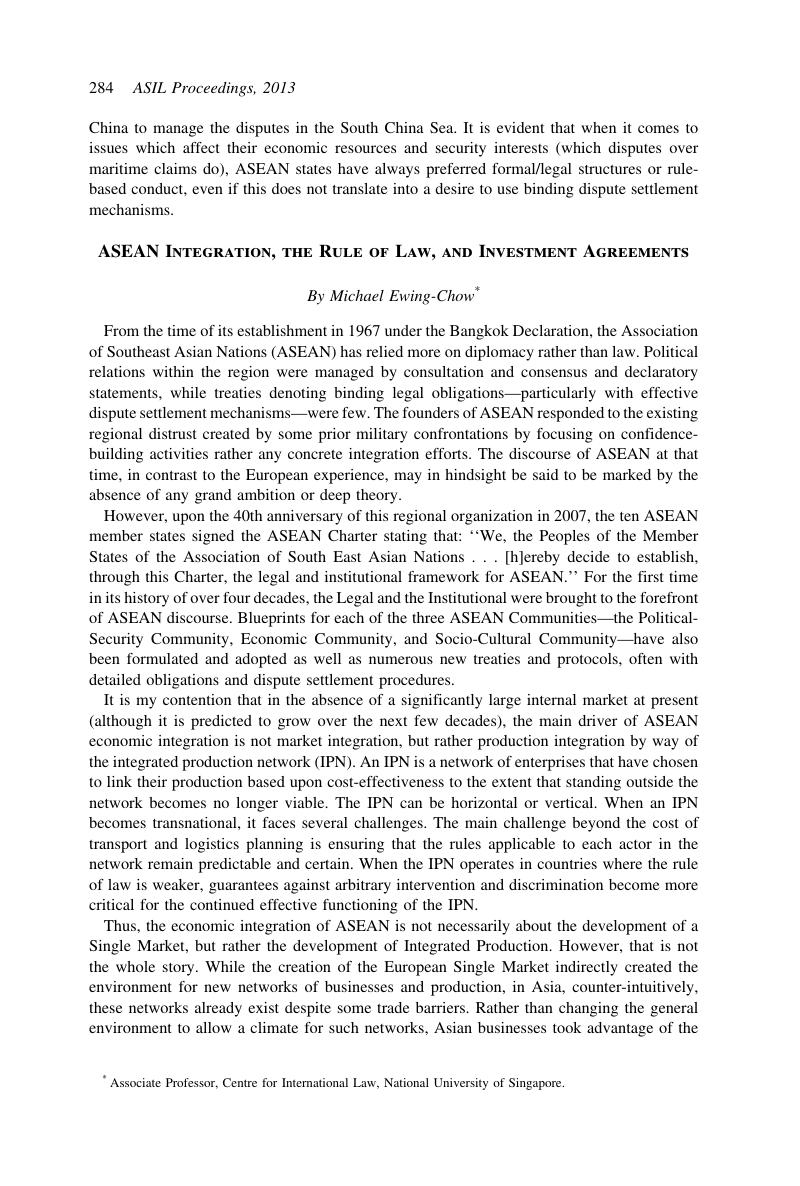Article contents
ASEAN Integration, the Rule of Law, and Investment Agreements
Published online by Cambridge University Press: 20 January 2017
Abstract

- Type
- The Challenges for ASEAN: The South China Sea, Investment Protection, and Myanmar
- Information
- Copyright
- Copyright © American Society of International Law 2014
References
1 See World Trade Organization, Trade Patterns and Global Value Chains in Asia, available at http://www.wto.org/english/res_e/booksp_e/stat_tradepat_globvalchains_e.pdf.
2 Dieter, Heribert, Transnational Production Networks in the Automobile Industry and the Function of Trade-Facilitating Measures 38 (Notre Europe, June 2007)Google Scholar.
3 Id. at 17–18.
4 Id.
5 Baldwin, Richard, Managing the Noodle Bowl: The Fragility of East Asian Regionalism (Ctr. for Econ. Poľ y Research, Working Paper No. 5561, Mar. 2006)Google Scholar.
6 Id.
7 Dieter, supra note 2, at 41–42.
8 Goldstein, Judith, Kahler, Miles, Keohane, Robert O. & Slaughter, Anne-Marie, Introduction: Legalization and World Politics, 54 Int’l Org. 385, 386 (2000)CrossRefGoogle Scholar.
9 Abbott, Kenneth W. et al., The Concept of Legalization, 54 Int’l Org. 401, 403 (2000)CrossRefGoogle Scholar.
10 Id. at 408.
11 Id. at 403.
12 Thomas Franck, The Power of Legitimacy Among Nations (1990), quoted in Abbott et al., supra note 9, n.27.
13 Abbott et al., supra note 9, at 403.
14 Id. at 415.
15 Id. at 408.
16 1987 ASEAN Agreement for the Promotion and Protection of Investment art. II(1), at http://www.asean.org/12812.htm (emphasis added).
17 ACIA Article 4(a) states that a “covered investment” means:
an investment in its territory of an investor of any other Member State in existence as of the date of entry into force of this Agreement or established, acquired or expanded thereafter, and has been admitted according to its laws, regulations, and national policies, and where applicable, specifically approved in writing [n.1] by the competent authority of a Member State. Footnote 1 provides that the processes specified in Annex 1 apply to Approval in Writing.
18 Id.
19 Yaung Choi Oo v. Myanmar, 42 ILM 540 (2003), ASEAN ID Case No. ARB/01/1 (Decision on Jurisdiction, Mar. 31, 2003) (Sucharitkul, Crawford, Delon).
20 YCO, paras. 60 et seq.
21 ACIA, Annex 1 “Approval in Writing”; AKIA, Annex 1 “Approval in Writing.”
22 General Agreement on Tariffs and Trade (GATT), Oct. 30, 1947, T.I.A.S. No. 1700, 55 U.N.T.S. 194.
23 ACIA art. 17(1); AKIA art. 21(1); ACHIA art. 16(1). See Michael Ewing-Chow & Kirtan Prasad, Creating Policy Space? The Inclusion of the General Exception in the ASEAN Comprehensive Investment Agreement and the ASEAN-China ETA Chapter (forthcoming) (discussing different methods for analyzing the General Exception).
24 1998 ASEAN Framework Agreement art. 13. The AANZFTA does not contain such a broad general exception clause, only incorporating the national treasure exception for investment obligations. AANZFTA, ch. 15, art. 1(4).
25 In AKIA and ACIA, the public order exception applies only when there is a genuine and sufficiently serious threat posed to a fundamental interest of society. AKIA art. 20 (1)(a) n.22; ACIA art. 17, n.12.
26 AKIA only allows for a violation of the national treatment obligation with respect to this exception. AKIA art. 20(1)(d).
27 ACIA art. 17(1); AKIA art. 21(1); ACHIA art. 16(1).
28 Continental Casualty Co. v. Argentine Republic, ICSID Case No. ARB/03/9 (Award, Sept. 5, 2008) (Sacerdotti, Veeder, Nader), at http://italaw.com/documents/ContinentalCasualtyAward.pdf.
29 Alvarez, José E. & Brink, Tegan, Revisiting the Necessity Defense: Continental Casualty v. Argentina (Inst. for Int’l Law & Justice, Working Paper 2010/3)Google Scholar.
- 1
- Cited by


